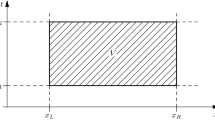Abstract
An efficient spectral vanishing viscosity method for the large-eddy simulation of incompressible flows is proposed, both for standard spectral and spectral element approximations. The approach is integrated in a collocation spectral Chebyshev-Fourier solver and then used to compute the turbulent wake of a cylinder in a crossflow confined geometry (Reynolds number Re=3900)
Similar content being viewed by others
References
Adams N.A., and Stolz S. (2002). A subgrid-scale deconvolution approach for shock capturing. J. Comput. Phys. 178: 391–426
Azaiez M., Fikri A., and Labrosse G. (1994). A unique grid spectral solver of the nD Cartesian unsteady Stokes system. Illustrative numerical results. Finite Elem. Anal. Des. 16(3–4):247–260
Botella O. (1997). On the solution of the Navier-Stokes equations using Chebyshev projection schemas with third order accuracy in time. Comput. Fluids 26(2):107–116
Cousin L., and Pasquetti R. (2004). High-order methods for the simulation of transitional to turbulent wakes.In:Lu Y., Sun W., and Tang T (eds). Advances in Scientific Computing and applications, Science Press Beijing/New York
Deville, M. O., Fischer, P. F., and Mund, E. H. (2002). High-order methods for incompressible flows, Cambridge University Press
Gatsky, T. B., Hussaini, M. Y., and Lumley, J. L. (1996). Large Eddy Simulation, In Ferziger, J. H. (ed.). in Simulation and modeling of turbulent flows. ICASE/LaRC Series in Computational Science and Engineering, Oxford University Press, pp. 109–154
Gottlieb D., and Shu C.W. (1997). On the Gibbs phenomenon and its resolution. SIAM Rev. 39(4):644–668
Chen G.Q., Du Q., and Tadmor E. (1993). Spectral viscosity approximations to multidimensional scalar conservations laws. Math. of Comput. 204: 629–643
Guo B., Ma H., and Tadmor E. (2001). Spectral vanishing viscosity method for nonlinear conservation laws. SIAM J. Numer. Anal. 39(4):1254–1268
Kaber O.S.M. (1995). A Legendre pseudo-spectral viscosity method. J. Comput. Phys. 128(1):165–180
Karamanos G.S., and Karniadakis G.E. (2000). A spectral vanishing viscosity method for large-eddy simulation. J. Comput. Phys. 163: 22–50
Kravchenko A.G., and Moin P. (2000). Numerical studies of flow over a circular cylinder at Re=3900. Phys. Fluids 12(2):403–417
Ma X., Karamanos G.S., and Karniadakis G.E. (2000). Dynamic and low-dimensionality of a turbulent near wake. J. Fluid Mech. 410: 29–65
Ma H. (1998). Chebyshev-Legendre superspectral viscosity method for non linear conservation laws. SIAM J. Numer. Anal. 35(3):893–908
Maday Y., Patera A.T., and Ronquist E.M. (1990). An operator-integration-factor splitting method for time-dependent problems: application to incompressible fluid flow. J. of Sci. Comp. 5(4):263–292
Maday Y., Kaber S.M.O., and Tadmor E. (1993). Legendre pseudo-spectral viscosity method for nonlinear conservation laws. SIAM J. Numer. Anal. 30(2):321–342
Ong L., and Wallace J. (1996). The velocity field of the turbulent very near wake of a circular cylinder. Experiments in fluids 20: 441–453
Pasquetti R., and Xu C.J. (2002). High-order algorithms for large eddy simulation of incompressible flows. J. Sci. Comp. 17(1–4):273–284
Pasquetti R. (2004). On inverse methods for the resolution of the Gibbs phenomenon. J. of Comput. and Appl. Math 170: 303–315
Pasquetti R. (2005). High-order LES modeling of turbulent incompressible flow. C.R. Acad. Sci. (Mécanique) 333: 39–49
Pasquetti, R. (in press). Spectral vanishing viscosity method for LES: sensitivity to the SVV control parameters. J. of Turbulence
Peyret, R. (2001). Spectral Methods for Incompressible Flow, Applied Mathematical Sciences 148, Springer.
Stolz S., and Adams N.A. (1999). An approximate deconvolution procedure for large-eddy simulation. Phys. Fluids 11(7):1699–1701
Tadmor E. (1989). Convergence of spectral methods for nonlinear conservation laws. SIAM J. Numer. Anal. 26(1):30–44
Xu C.J., and Pasquetti R. (2001). On the efficiency of semi-implicit and semi-Lagrangian spectral methods for the calculation of incompressible flows. Inter. J. Numer. Meth. Fluids 35: 319–340
Xu C.J., and Pasquetti R. (2004). Stabilized spectral element computations of high Reynolds number incompressible flows. J. Comput. Phys. 196(2):680–704
Author information
Authors and Affiliations
Corresponding author
Rights and permissions
About this article
Cite this article
Pasquetti, R. Spectral Vanishing Viscosity Method for Large-Eddy Simulation of Turbulent Flows. J Sci Comput 27, 365–375 (2006). https://doi.org/10.1007/s10915-005-9029-9
Received:
Accepted:
Published:
Issue Date:
DOI: https://doi.org/10.1007/s10915-005-9029-9




